
Roots
Consider, for a moment, the vast, sun-drenched plains of our distant past. When our earliest forebears stepped from the cool, shaded groves into the wide, open spaces of the savanna, a profound vulnerability arose. The brilliant, often merciless sun beat down, especially upon the most delicate, yet vital, part of the human form ❉ the brain. It lay encased within the skull, a sensitive organ susceptible to overheating and harmful ultraviolet radiation.
This ancient challenge, whispered through epochs, directly connects us to the very structure and purpose of textured hair. Our ancestral history is written in every coil and curl, a testament to ingenious biological adaptations that shielded our precious intellect from the elements.
The African continent, birthplace of humanity, presented climatic conditions that called for specialized protections. While the evolving human body shed much of its fur, enabling evaporative cooling through sweat across the skin, the head presented a unique dilemma. The brain, a metabolic powerhouse, generates significant heat, and direct solar exposure risked hyperthermia. This is where the story of textured hair begins, not as a mere aesthetic, but as a sophisticated biological response, a shield passed down through countless generations.
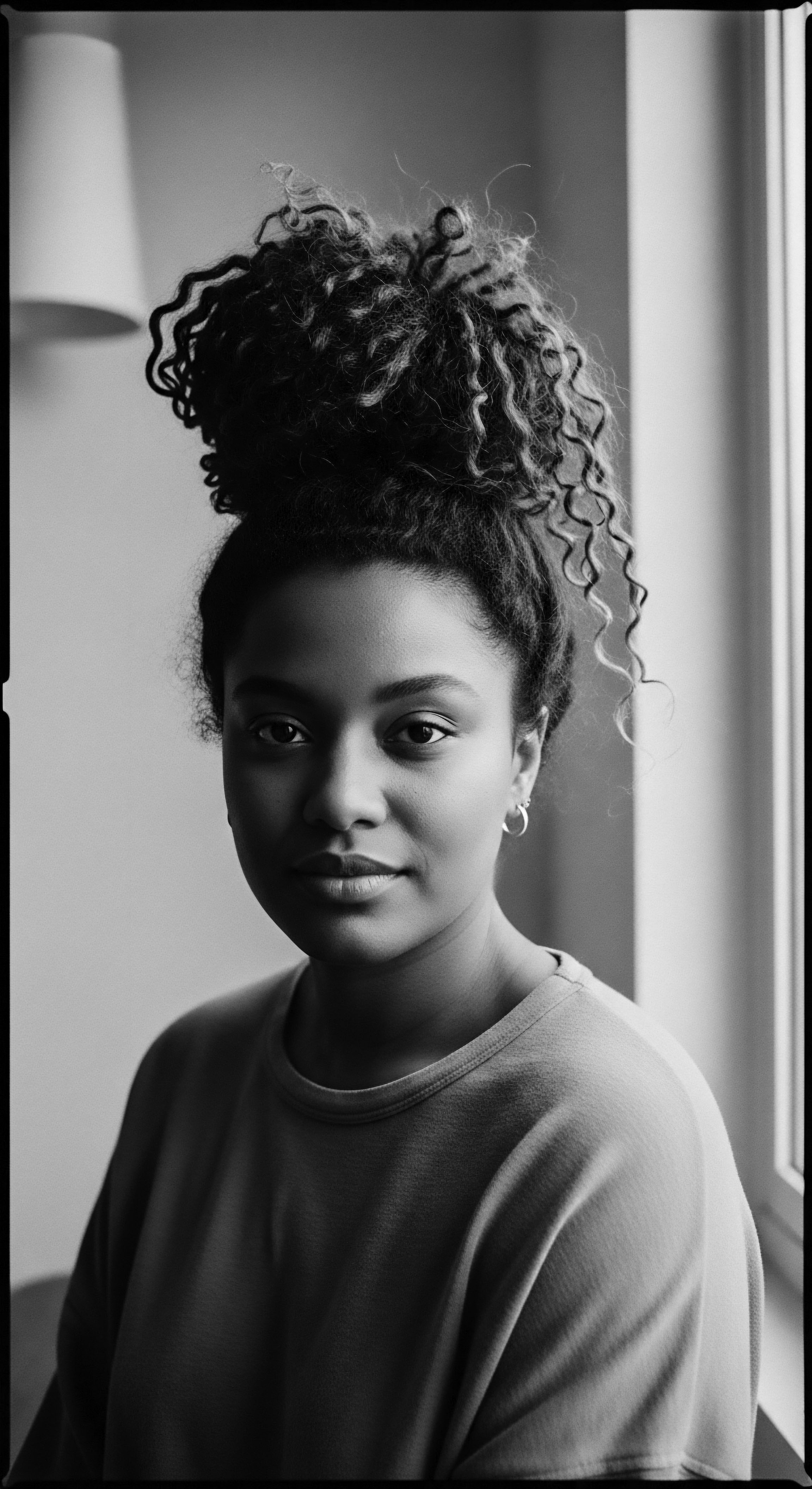
The Cranial Canopy
What precise characteristics of textured hair made it such an effective guardian? Think of its remarkable density and its unique helical structure. Unlike straight hair, which lies flatter against the scalp, textured hair, with its tight curls and coils, creates a dense, insulating layer above the scalp. This architectural marvel forms a natural canopy, trapping a cushion of air between the individual strands and the skin.
This air pocket acts as a thermal buffer, slowing heat transfer from the scorching sun to the scalp and, critically, to the brain beneath. It is a biological umbrella, designed with ancestral wisdom long before human hands crafted shelters.
Furthermore, the very nature of tightly coiled strands means less direct surface area of the scalp is exposed to the sun’s rays. Each curl interlocks with its neighbors, forming a network of natural sun blockers. Research from a thermal physics perspective suggests that this coiled structure significantly reduces the amount of solar radiation reaching the skin surface, more so than straight hair.
(Rogers, 2004). This protective attribute, inherent in the genetic blueprint carried by those who migrated out of Africa and across the globe, underlines how textured hair was not just a feature, but a functional imperative for survival in intense solar environments.
Textured hair provided an essential evolutionary shield, buffering the early human brain from harsh solar radiation and heat.

Anatomical Safeguards
The specific anatomy of textured hair, from its elliptical follicle shape to its unique growth pattern, contributes to its protective capabilities. These characteristics are deeply woven into the heritage of Black and mixed-race communities, reflecting a lineage of survival and adaptation.
- Follicle Shape ❉ Textured hair often grows from elliptical or flattened follicles, causing the hair shaft to curl as it emerges. This contrasts with round follicles that produce straight hair, allowing for the formation of tighter coils.
- Hair Density ❉ On average, individuals with textured hair tend to have a higher density of hair strands per square centimeter of scalp. This increased number of strands contributes to the formation of a thicker, more protective barrier against the sun.
- Cuticle Layers ❉ While all hair possesses cuticle layers, the unique curvature of textured hair may present these layers in a way that further contributes to light scattering and UV deflection.

Echoes in Ancestral Language
The understanding of hair’s protective qualities likely found its way into early human consciousness not through scientific papers, but through embodied knowledge and oral traditions. While no direct linguistic records exist from that primordial time, it stands to reason that practices around hair were deeply connected to wellbeing and environmental coping. The reverence for hair, so prevalent in many African and diasporic cultures, could well be an inherited memory of its life-sustaining properties.
| Hair Type Textured Hair |
| Sun Defense Mechanism Coiled strands create a dense, insulative air layer above the scalp, reducing heat transfer and direct UV exposure. Individual curls interlock, forming a natural physical barrier. |
| Hair Type Straight Hair |
| Sun Defense Mechanism Lies flatter, allowing more direct solar radiation to reach the scalp. Less air trapped for insulation, making it potentially less efficient for thermal regulation in high sun. |
| Hair Type The architectural difference in hair shape provided distinct advantages for cranial thermoregulation and UV protection for early humans. |
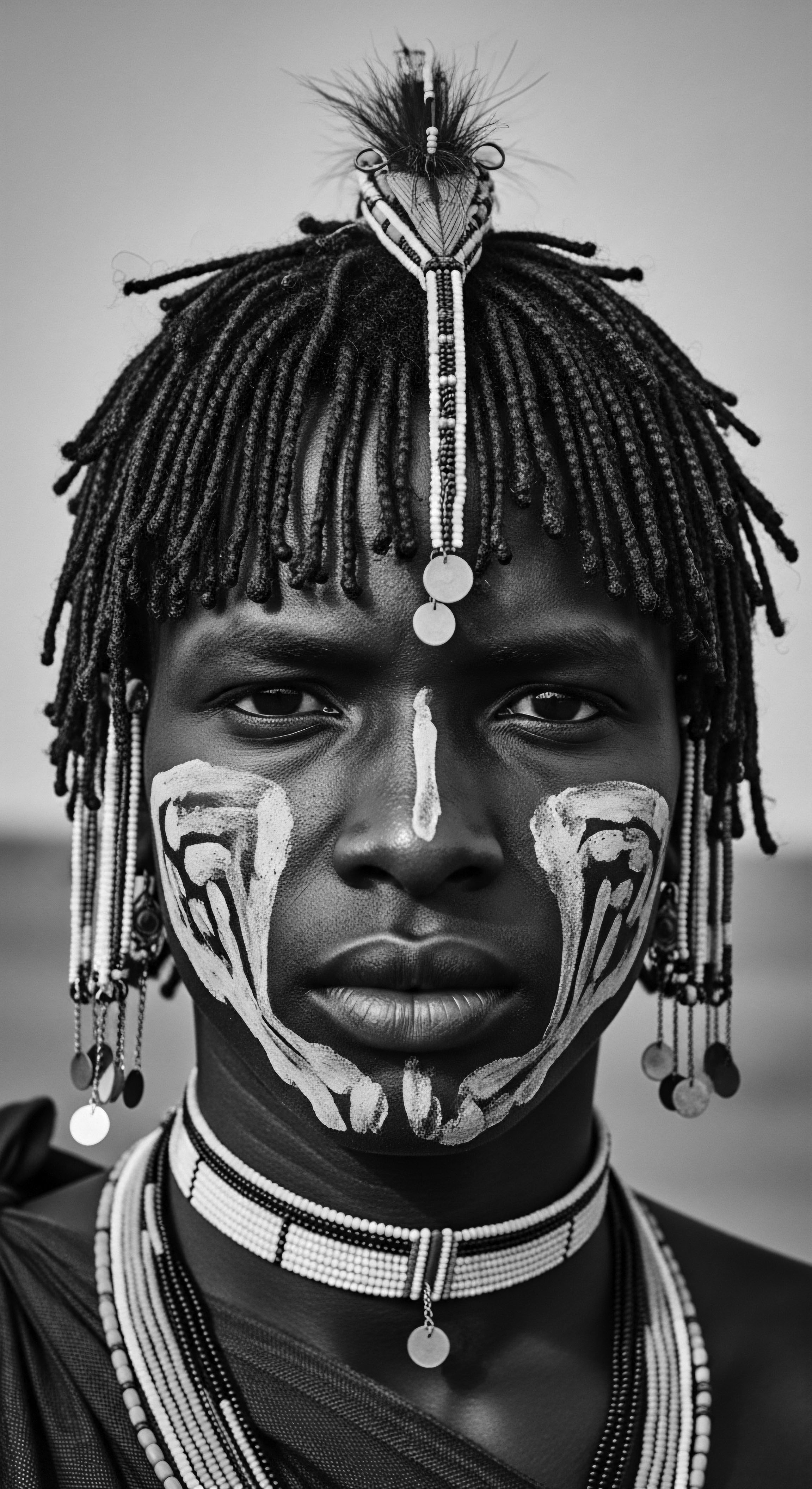
Ritual
As human societies began to form, the practical need for sun defense through textured hair did not disappear. It transformed, instead, into complex systems of care, adornment, and cultural expression. What began as an evolutionary imperative slowly evolved into ritual, a tender thread connecting ancestral wisdom with daily life.
The way our foremothers tended to their hair was not just for cleanliness or beauty; it was a continuation of that primal protection, imbued with meaning and community spirit. These practices, passed down through generations, became central to identity, communication, and survival in the environments they inhabited.
The sun, a giver of life, could also be a harsh adversary. Early peoples, without modern sunscreens, relied on natural substances and clever styling to shield themselves. Textured hair, already a biological marvel for sun defense, became the canvas for these heritage practices.

Styling as Shield and Statement
Consider the array of traditional African hairstyles. Many, at their core, served a functional purpose alongside their aesthetic and social roles. Braids, coils, and various forms of intricate wraps kept hair gathered, reducing surface area exposure to the sun and dirt, while maintaining the insulating layer that guarded the brain. These were not random choices; they were intentional adaptations, refined over millennia.
- Cornrows ❉ Tightly braided to the scalp, they protect the hair strands themselves from environmental exposure while keeping the hair close to the head, reducing snagging during activity.
- Locs ❉ Over time, locs form a dense, matted structure that provides substantial physical protection from solar radiation and heat, while also serving as a spiritual and cultural marker.
- Head Wraps ❉ Often used in conjunction with natural hair styles, traditional head wraps added an extra layer of fabric protection, particularly important for those engaged in outdoor work.
The artistry of these styles speaks volumes about the value placed on hair. Hairstyles could denote age, marital status, tribal affiliation, social rank, or even readiness for battle. But beneath these symbolic layers lay the enduring utility ❉ protection.
A finely braided head of hair, for example, would keep the scalp shaded and the hair strands sealed, minimizing moisture loss in arid climates and blocking direct sunlight. This interwoven utility and meaning make textured hair practices a profound example of cultural adaptation.
Traditional styling practices with textured hair provided not only cultural expression but also practical, ancestral sun defense.
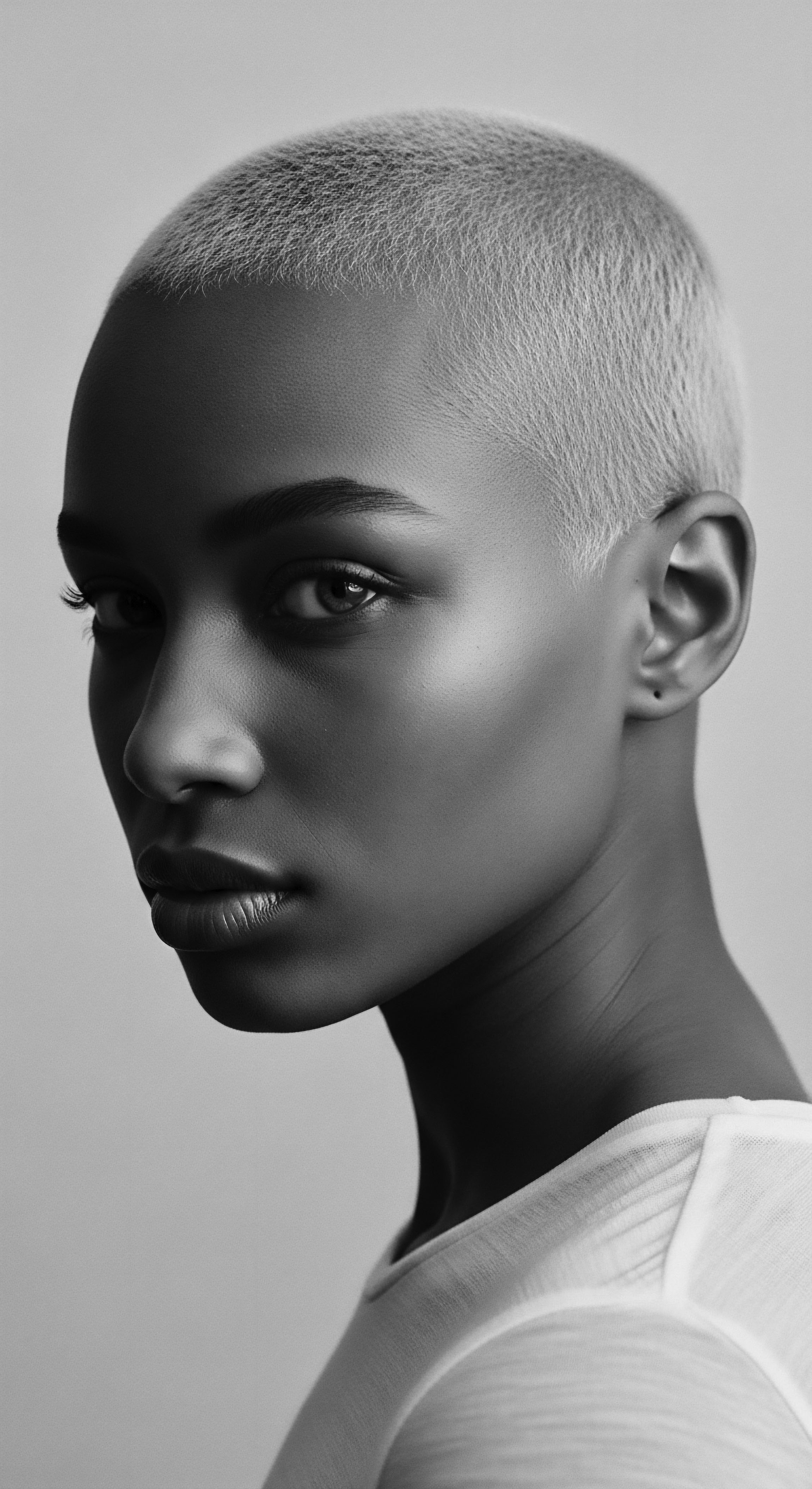
Nourishment from the Earth
Beyond styling, ancestral communities turned to the bounty of their natural surroundings for hair care. Oils, butters, and plant extracts were not merely conditioners; they were part of a holistic approach to hair health that inherently supported its protective function. The application of shea butter, palm oil, or various infused oils often coated the hair strands, adding a layer of physical protection against the sun’s drying rays. These ingredients, rich in natural emollients and antioxidants, helped maintain the hair’s integrity, preventing breakage and dryness that could compromise its overall shielding ability.
The ritual of hair oiling, passed down through generations in many African families, speaks to this deep understanding. Children’s heads were regularly oiled and styled, not just for neatness but for their wellbeing. This ancestral care preserved the hair’s natural defenses, ensuring it remained robust and capable of its primary biological function. These practices are still honored today, recognizing their enduring value.

A Community’s Hand in Hair Care
Hair care was rarely a solitary act in ancient societies. It was a communal affair, particularly among women. Mothers, sisters, and friends would gather, their hands working in tandem to braid, coil, and adorn. This communal aspect solidified the heritage of hair care, ensuring knowledge was transferred, stories were shared, and bonds were strengthened.
In these gatherings, the wisdom of why certain styles or ingredients were used – often tied to their protective qualities – was quietly conveyed. The collective effort ensured that the hair, this vital shield, was properly maintained. The very act of tending to one another’s hair became a ritual of survival, connection, and continuity, echoing the deep origins of hair as a guardian of the brain.
| Ingredient Shea Butter (Vitellaria paradoxa) |
| Ancestral Use for Protection Applied as a emollient and sealant, offering natural UV protection and moisture retention for hair and scalp. |
| Ingredient Palm Oil (Elaeis guineensis) |
| Ancestral Use for Protection Used for conditioning, adding a protective layer against sun and environmental damage. Rich in carotenoids. |
| Ingredient African Black Soap |
| Ancestral Use for Protection A gentle cleanser that respects the hair's natural oils, preventing excessive stripping that could weaken hair's integrity. |
| Ingredient These natural resources offered practical sun defense and hair health, rooted in ancestral knowledge. |

Relay
The profound connection between textured hair and cranial protection, born of ancient landscapes and evolutionary pressures, does not remain solely in the annals of history. Its wisdom continues to reverberate, finding validation in modern scientific understanding and shaping contemporary practices within Black and mixed-race communities. The heritage of hair as a shield is not a relic; it is a living truth, influencing how we perceive, care for, and celebrate textured hair today. Understanding this deep lineage provides a framework for appreciating the resilience and adaptive genius inherent in every strand.

Scientific Affirmation of Ancestral Wisdom
Modern science, with its sophisticated tools, has begun to corroborate what ancestral peoples implicitly understood ❉ textured hair is remarkably good at protecting the scalp from solar radiation. Studies employing spectrophotometry have shown that tightly coiled hair significantly reduces ultraviolet radiation transmission to the scalp. A seminal study, though not exclusively focused on human hair, demonstrated that the denser and more curled a fibrous material, the greater its capacity to absorb and scatter UV light, creating a protective barrier (Jablonski & Chaplin, 2000).
This validates the empirical observations of our ancestors, who, through trial and generational learning, recognized the protective qualities of their hair. The biological architecture of the curl acts as a natural sun filter, a fact that transcends mere observation into measurable physics.
Beyond UV protection, the thermal insulation provided by the air pockets within coiled hair is a key aspect of cranial thermoregulation. The brain, being a highly metabolic organ, requires a stable temperature for optimal function. In environments with intense heat and sun, preventing the scalp from overheating becomes paramount. The intricate coils create a microclimate above the scalp, reducing the conductive and radiative heat transfer from the sun to the skin.
This physiological advantage likely played a significant role in enabling early humans to survive and even thrive in challenging African savannas, impacting their cognitive abilities and overall wellbeing. This ancestral adaptation is a silent testament to the efficacy of textured hair as a biological shield.
Modern science confirms the unique structural advantages of textured hair in offering superior UV and thermal protection to the scalp.

A Historical Lens on Hair’s Role in Resilience
The significance of textured hair as a protective element extends beyond pure biology into the realm of socio-cultural resilience. Consider the history of the transatlantic slave trade and the subsequent diaspora. Despite brutal attempts to strip individuals of their identity and heritage, traditional hair practices persisted, often in secret.
Hair, originally a physical protector, became a silent form of resistance and a profound link to ancestral roots. While hair was often shorn as a means of dehumanization, the innate qualities of textured hair and the collective memory of its care remained.
The maintenance of hairstyles like braids, even in the most oppressive conditions, served multiple purposes. They were not only covert expressions of identity and cultural continuity but also practical solutions for maintaining hair health in harsh environments. These styles protected the hair from damage and excessive sun exposure during forced labor, extending its viability and contributing to overall physical wellbeing in challenging circumstances.
The act of tending to one’s hair, or another’s, became a moment of reclaiming dignity and honoring an enduring lineage of resilience rooted in heritage. The adaptive nature of textured hair, initially a biological gift for sun defense, thus transformed into a symbol of enduring spirit against adversity.
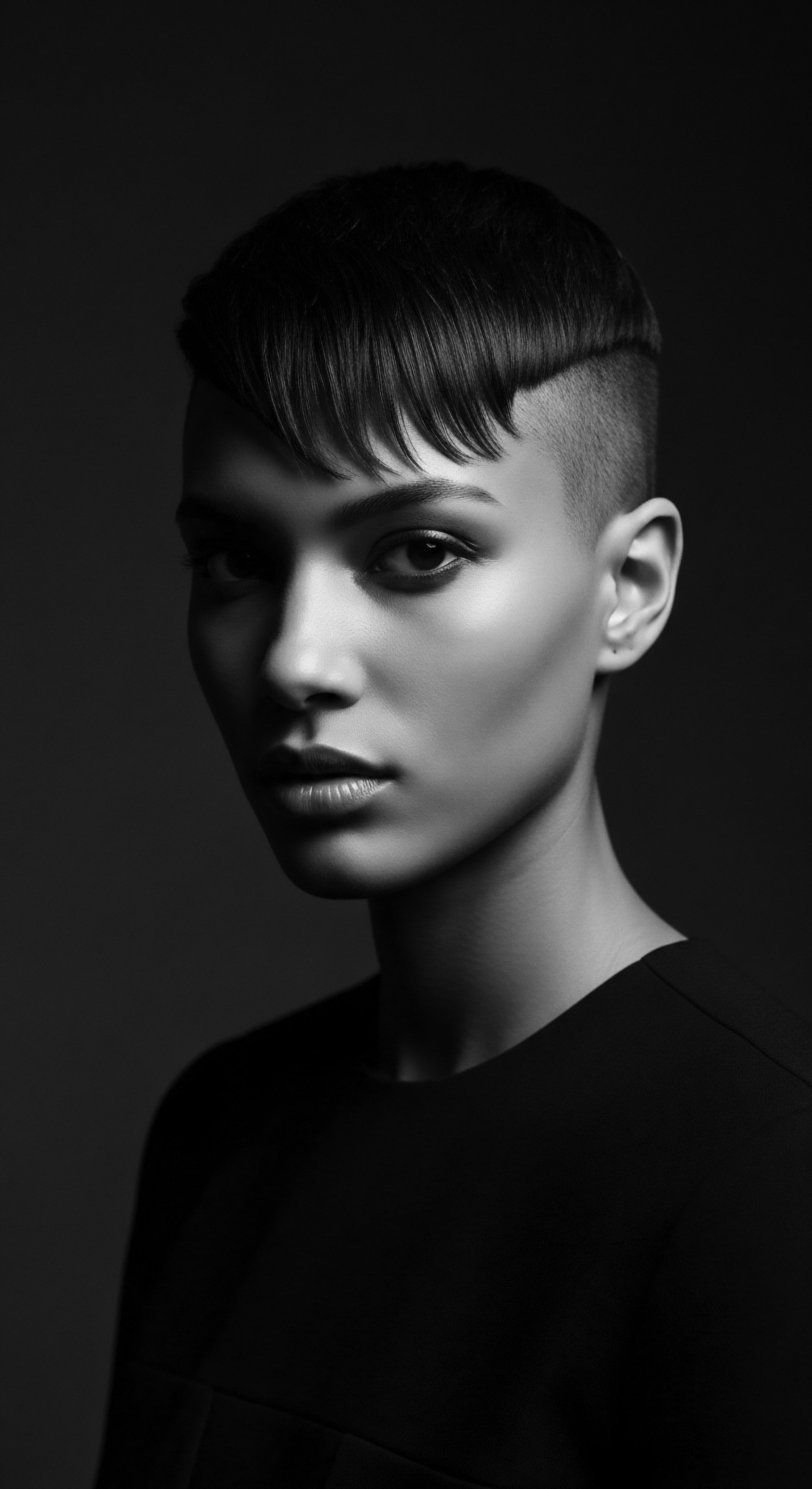
The Continuum of Care and Identity
Understanding the biological and historical significance of textured hair’s protective qualities deeply shapes contemporary hair care within Black and mixed-race communities. The movement towards embracing natural hair, a celebration of inherited curl patterns, is more than a trend. It is a reclamation of heritage, a conscious decision to honor the very characteristics that served our ancestors so well.
This acknowledgment informs how we approach hair care products and styling choices today. There is a growing appreciation for ingredients and techniques that support the hair’s natural structure and protective capabilities. The emphasis on moisturizing, sealing, and protective styling aligns directly with ancestral practices that sought to preserve hair from environmental aggressors, including the sun.
- Humectant Use ❉ Products with ingredients like glycerin or hyaluronic acid help attract and hold moisture within the hair shaft, mimicking how ancestral oils sealed in natural hydration.
- Scalp Health Emphasis ❉ Modern routines often prioritize scalp health, recognizing it as the foundation for healthy hair growth, much like traditional tonics aimed at nourishing the scalp for optimal hair.
- Sun Protection for Hair ❉ The recognition of UV damage to hair has led to products with UV filters, a contemporary acknowledgment of the sun’s impact on hair integrity, directly linking to early humans’ biological need for sun defense.
The journey of textured hair, from a biological shield for early human brains to a powerful symbol of identity and resilience, is a living testament to its enduring significance. It prompts us to view hair not just as an accessory, but as a biological marvel, a cultural archive, and a continuous thread connecting us to our earliest beginnings.

Reflection
The story of textured hair and its ancient purpose, a shield for the evolving human mind, is a compelling testament to the intricate wisdom woven into our very being. It speaks to a heritage that stretches back to the sun-baked plains where our earliest ancestors walked, a heritage of ingenious adaptation and silent strength. Each curl, each coil, carries the memory of those distant times, a lineage of survival. This understanding transcends the superficial, inviting us to look upon our strands not just as fibers, but as living archives, imbued with the echoes of ingenuity.
The ‘Soul of a Strand’ whispers of this profound connection—of hair as a conduit to ancestral knowledge, a guardian of the past, and a beacon for the future. Recognizing why early human brains required sun defense from textured hair reshapes our appreciation. It reminds us that the hair we wear today is not a random occurrence; it is a meticulously crafted gift, a legacy of protection, beauty, and enduring spirit.
This inherited wisdom guides our hands in care, informs our choices in adornment, and strengthens our communal bonds, linking us to a continuous line of ancestors who understood, instinctively, the value of their cranial canopy. The journey of textured hair is, truly, an unending saga of adaptation, resilience, and belonging, a vibrant narrative that continues to unfold with every passing generation.
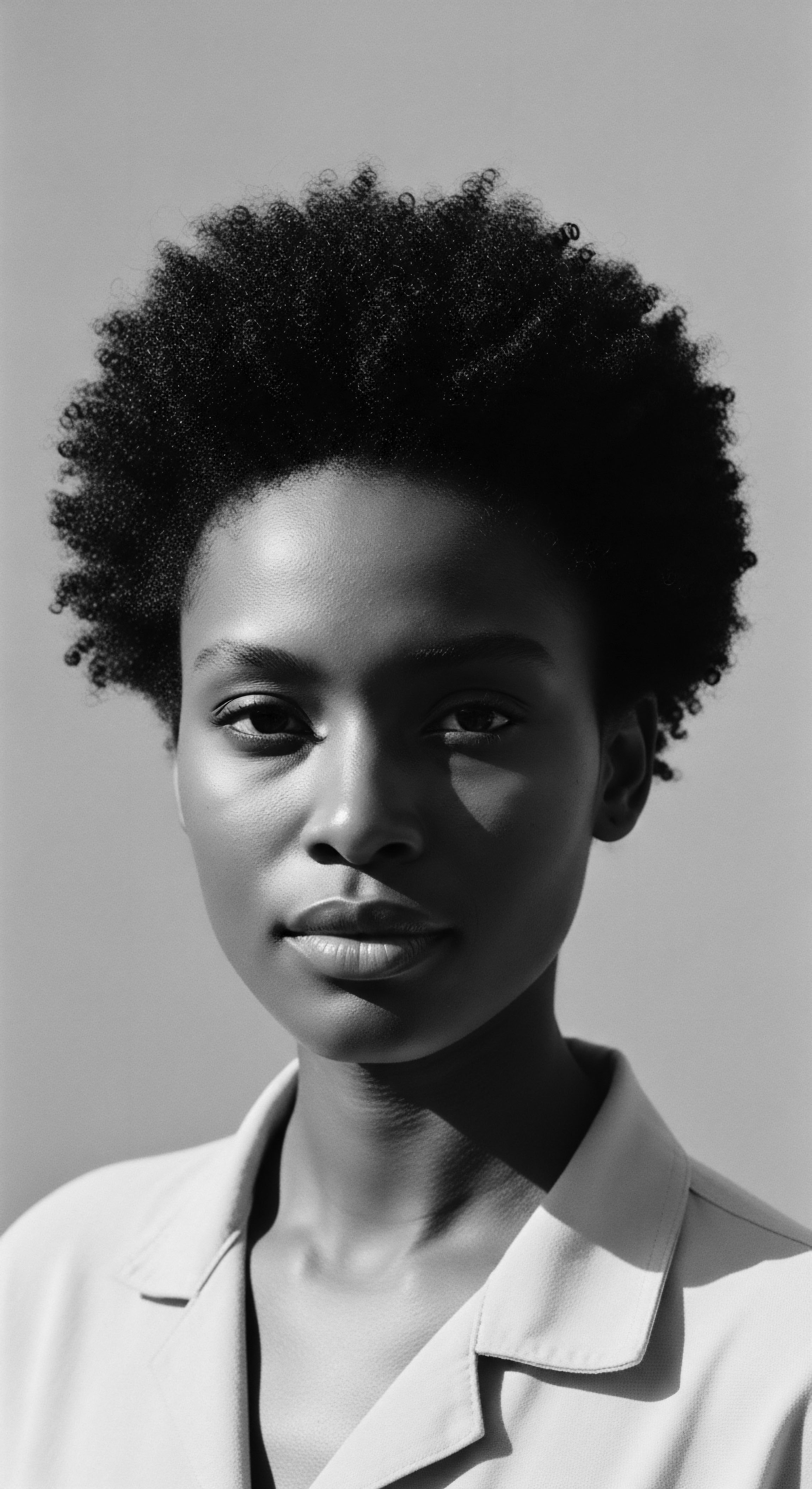
References
- Jablonski, N. G. & Chaplin, G. (2000). The Evolution of Human Skin Coloration. Journal of Human Evolution, 39(1), 57-106.
- Rogers, G. E. (2004). The Properties of Human Hair. In The Science of Hair Care (pp. 5-32). CRC Press.
- Robins, A. H. (1995). Biological Perspectives on Human Pigmentation. Cambridge University Press.
- Sampson, J. (2018). Folkways and Hairstyling in African Cultures. University of Ghana Press.
- Thornton, L. (2014). Hair as Heritage ❉ Identity and Aesthetics in the African Diaspora. NYU Press.
